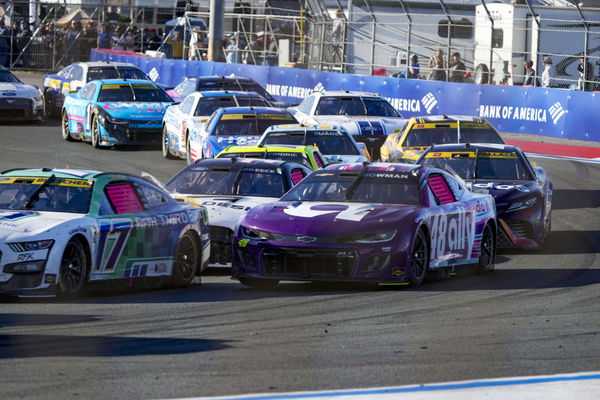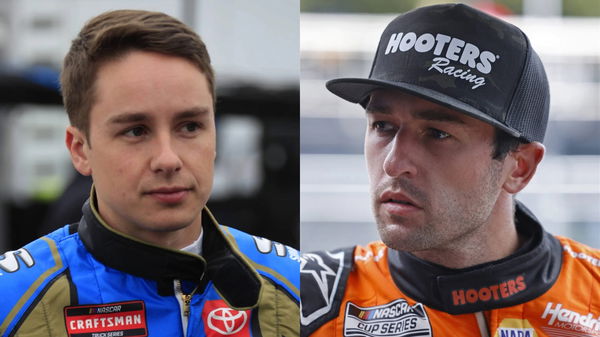Should NASCAR Continue Running on Road Courses or Limit Itself to Oval Layouts?

Follow Us

USA Today via Reuters
Oct 8, 2023; Concord, North Carolina, USA; Cars crowd into turn four after a restart during the Bank of America Roval 400 at Charlotte Motor Speedway Road Course. Mandatory Credit: Jim Dedmon-USA TODAY Sports
The first thing that springs to mind when it comes to NASCAR is oval racing. There is an age-old stereotype that NASCAR is nothing but cars literally driving in circles. Motorsports like Formula One, endurance racing, and others usually run on proper circuits. However, it is worth mentioning that the very first NASCAR road course race was at the Linden Airport all the way back in 1954.
Since then, there have been more than 150 road course races in the stock car series’ history. Since 1954, there has been at least one road course race on the calendar. However, that lasted until 1959, and there were no more road course races until the 1961 season, and the Augusta International Raceway was the sole road course in 1962. In essence, road courses have always been part of NASCAR’s history but were normally limited to one or two races.
When did the popularity of road course NASCAR races rise?
ADVERTISEMENT
Article continues below this ad
It is only fairly recently that road course racing has risen back into prominence in the 2000s. As mentioned before, there have always been road course NASCAR races, but their oval counterparts outnumbered them. Now though, more and more road courses are popping up and winding up on the calendar. The most prominent ones are Watkins Glen, Sonoma, and the Indianapolis Motor Speedway Road Course.

USA Today via Reuters
Aug 13, 2023; Speedway, Indiana, USA; NASCAR Cup Series driver Chase Elliott (9) during the Verizon 200 at the Brickyard at Indianapolis Motor Speedway Road Course. Mandatory Credit: Mike Dinovo-USA TODAY Sports
Even the Circuit of The Americas has joined the party and has been a mainstay since 2021. Aside from that, some of the speedways have had an inner road course built into it. This includes the Daytona International Speedway and the Charlotte Motor Speedway. With the introduction of the Playoff system in 2004, it was interesting to note that no road course hosted a Playoff race for a while. All of that changed in 2018 with the Charlotte Motor Speedway switching to its road course layout. As a result, the race was renamed from Bank of America 500 to Bank of America Roval 400.

NASCAR’s Next-Gen Platform Is a Level Up for the Sport, Here’s Why
What was the reason behind the road course inclusion in the Playoffs?
Trending

“He About Wrecked Us Twice”- Livid Kyle Busch Sounds off on Martin Truex Jr, Voices Displeasure on Drivers Next-Gen “Defense Item”
April 29, 2024 10:47 AM EDT

Christopher Bell Trashes Chase Elliott’s “Helpful” Narrative by Condemning NASCAR’s “Useless” Formality
April 28, 2024 08:40 PM EDT

Denny Hamlin Takes a Shot at Kyle Larson as the HMS Driver Brings Up Petty Issues After Coming Up Short
April 29, 2024 04:40 AM EDT

Next-Gen Stats Sell Out Richard Childress’ Disgruntled Grandson as Riled Up Fans Beg to Preserve Dale Earnhardt’s Legacy
April 30, 2024 07:55 AM EDT

Despite Cold Shouldering Joe Gibbs, MTJ Drops a Surprising 7-Word Revelation on Their Dynamic
April 25, 2024 06:40 PM EDT
Get instantly notified of the hottest NASCAR stories via Google! Click on Follow Us and Tap the Blue Star.

Follow Us
Until 2018, NASCAR did not entertain any thoughts of allowing a road course to host a Playoff race. It was only thanks to the fans who wanted this inclusion and the sport obliged. The then NASCAR Senior Vice President of Racing Operations Jim Cassidy admitted that they listened to the fan base. In essence, the audience wanted the stock car racing series to evolve, and the sport was only too happy to experiment.
Of course, this was not a spur-of-the-moment decision from either party. There were several tests conducted on the Roval and the officials liked the results. With this, NASCAR was able to change up the formula and keep audiences interested and engaged. Furthermore, the presence of these road courses helps challenge the drivers’ skills on the racetrack.
What do the road courses offer the NASCAR drivers?
The ovals only have corners that head in the same direction with the occasional banking. Road courses, on the other hand, present a variety of challenges. For cars that are used to turning left, these tracks boast moderate hills, narrower turns, varying banking, and even right turns. Sure, ovals make NASCAR unique, when compared to the likes of IndyCar and Formula One. However, the fans were certainly not complaining about the inclusion of road courses.
In 2021, NASCAR added 7 road course races to their schedule, which is the highest number. Admittedly, the response was fairly mixed, but leaned towards the positive spectrum. Most fans were thrilled, but others insisted that ovals distinguished NASCAR from IndyCar and Formula 1. Currently, only one track is shared between all three series, namely the Circuit of The Americas. However, one has to wonder if NASCAR will explore the Miami International Autodrome and the Las Vegas Strip Circuit. Formula One visited the former in 2022 and again in 2023, and the latter is making its debut this year.
Do the NASCAR drivers like running on road courses?
If you asked someone like Chase Elliott, AJ Allmendinger, or Tyler Reddick, the answer would be a resounding yes. Of course, there will be others who are not so fond, because they have not been particularly successful. So the question with them is whether their disdain is genuine or just a case of sour grapes. Just recently, NASCAR took a gamble with the Chicago Street Course, earlier this year. Safe to say, the gamble paid off handsomely and it could be a regular fixture on the calendar.

via Imago
NASCAR, Motorsport, USA Cup Practice & Qualifying Aug 12, 2023 Speedway, Indiana, USA NASCAR Cup Series driver Shane Van Gisbergen 91 during practice for the Verizon 200 at the Brickyard at Indianapolis Motor Speedway Road Course. Speedway Indianapolis Motor Speedway Road Course Indiana USA, EDITORIAL USE ONLY PUBLICATIONxINxGERxSUIxAUTxONLY Copyright: xMikexDinovox 20230812_mcd_ad4_24
In the buildup to the inaugural event, there was definitely a lot of resistance. Come race day, there was plenty of excitement, and that weekend’s changeable weather made it a lottery. According to ex-NASCAR driver Clint Bowyer, the excitement and unpredictability of road course racing draws in a lot of fans. The inclusion of these races also introduced the concept of ‘road course ringers’. These drivers are ones who specialize in road courses and perform well on these tracks, as opposed to ovals.
ADVERTISEMENT
Article continues below this ad
What other benefits come from these road course races?
Furthermore, continuing the ‘road course ringer’ argument can also rope in top talent. Trackhouse Racing’s ambitious Project 91 program is the perfect example of this. This is because they coaxed F1 legend Kimi Raikkonen temporarily out of retirement to compete in two races for them. Then, they also roped in V8 Supercars star Shane van Gisbergen, and he even managed to win on his debut. Now, rumor has it that van Gisbergen could compete in NASCAR on a full-time basis.
Other teams began to follow that trend and more international stars competed. This includes the likes of Mike Rockenfeller, Brodie Kostecki, Travis Pastrana, Jordan Taylor, and Kamui Kobayashi. Rick Ware Racing even managed to coax Jenson Button out of retirement to run a few races for them. That acted as a springboard for Button to compete in the 24 Hours of Le Mans alongside Rockenfeller and Jimmie Johnson. The trio competed in a purpose-built modified NASCAR Next Gen Chevrolet Camaro, but that’s another story.
ADVERTISEMENT
Article continues below this ad
At the end of the day, NASCAR may be well known for its oval races, but road courses are also an integral part of it. Hence, limiting themselves to ovals would be a mistake from the governing body.
WATCH THIS STORY: How Shane Van Gisbergen’s Chicago Victory Became an Embarrassing Nightmare for Cup Drivers?
Edited by:
Ranvijay Singh
